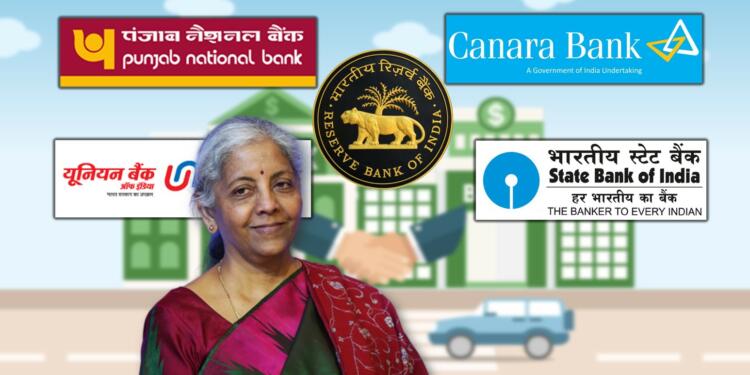The Verdict On Bank Mergers Is Published In An RBI Document

Banks. To various people, the phrase means different things. While it simply means a spot for deposits and loans to people like us, to experts it represents a brief summary of the larger economic picture. They categorize institutions primarily into two groups. Banks of all sizes can be found. Small banks are primarily needed when national economies require a boost of commoners’ liquidity. Nation states aim to have larger banks if that is effective.
These larger banks eventually develop into worldwide banking platforms, primarily helping the nation where their headquarters are located. India has recently discovered itself in the center of it. India has a responsibility to ensure that its population receives a minimal level of banking benefits, and at the same time, we must make future plans. The need for bank consolidation to create a larger institution is evident in this situation.
RBI report on bank consolidations
A study on bank mergers in India was recently released by the Reserve Bank of India. From the RBI website, we got the paper on bank mergers. “Do Bank Mergers Improve Efficiency? The Indian Experience” is the subject. The RBI paper on bank mergers analysis examines the mergers that will take place in India after 2022.
The authors primarily examined 15 financial measures. These measures take into account asset quality, NPA provisions, profitability, working efficiency, capital adequacy, and liquidity. While the outcomes of bank mergers during the early years of the post-liberalization period are well known, people are interested in learning how the Modi government’s most recent mergers will affect the economy.
Merger is required
In 2019, 10 public sector banks (PSBs) were combined into 4, according to extensive reporting by the TFI, reducing the overall number of PSBs from 27 to 12. There were numerous factors at play. For instance, having a significant quantity of PSBs was no longer absolutely necessary in 2019. mainly because PM Modi’s Jan Dhan Yojana had already begun to work its wonders. In the month of August 2019, there were almost 37 lakh Jan Dhan Accounts overall.
The total amount owned by these accounts was Rs. 1,02,415 crore. However, these figures were simply a formality, as one might expect given that only underprivileged villagers were depositing their meager savings in Jan Dhan accounts. The truth is that Jan Dhan Account holders have been provided enough options to escape the administrative chains of being unable to withdraw their own money on schedule. 75% of Jan Dhan Account users had their own debit cards at the time of the merger.
Following the initial rush of account openings, Jan Dhan Accounts and the Rupay Card eliminated the need for people to visit institutions for trivial matters. Other reasons for visiting banks for individuals at the bottom of the economic pyramid include making deposits and applying for loans. While the crowding caused by deposits will take some time to resolve, many new opportunities for more accessible loans have emerged in recent years. These also include some government-backed options, NBFCs, and legitimate credit applications.
PSBs were suffering, according to an RBI report on bank mergers
Along with declining requirements, legacy problems at PSB were another factor in the merger. PSBs used to simply work for the sake of working before the abrupt acceleration in work ethic brought on by JAM trinity and demonetization. Few of them had made a commitment to increase productivity. Instead of helping the needy, their officers used to lend money primarily to large corporations.
In reality, their loan portfolio increased by nearly threefold from Rs 18,19,074 crore on March 31, 2008, to Rs 52,15,920 crore on March 31, 2014. Before RBI tightened the standards, they did not even designate their failures as NPAs in an effort to conceal them. Losses accumulated in spite of that. These institutions cost the state exchequer Rs 2,07,329 crore between FY16 and FY20.
To make matters worse, it was becoming more difficult for them to obtain credit, which decreased their chances of learning from their past errors. Larger institutions also find it simple to follow Basel III regulations. To put things into context, PSBs in India had a pitiful market capitalization of Rs 5 lakh crore at the time of the merger.
That was the unfavorable context in which the merger choice was made. The suggestions of highly reliable documents like the reports of the PJ Nayak Committee and the M. Narasimham Committee are in accordance with bank mergers.
With the merger, the government aimed to lower operational costs, increase financial inclusion, expand the geographic reach of both the acquirer and acquiree banks, make a larger pool of expertise available, reduce the burden of recapitalization on the government, eliminate redundant positions, finance large projects, boost competitiveness, and create technological synergy. Simply stated, the merged entities were designed to operate more effectively.
Merging had a solid foundation and received favorable public opinion
to determine whether or not these merged entities reached the required level. Experts looked at both the acquirers’ and acquirees’ recent histories. The term past in this context refers to the three years prior to the union, and by present, researchers mean either the end of 2022 or two years following the merger. First, it was determined whether the bank that had purchased the other was more technologically advanced. Glance at the graph below. Just take a peek at the last column if you have trouble focusing.
In 4 of the 5 mergers, a less effective public sector bank was purchased by the more effective one.
This truth was also supported by the markets. An efficient entity purchasing a less efficient one is a poor move for shareholders of efficient banks. Similarly to this, it is excellent news for shareholders of inefficient banks when a larger player steps in to save their institutions. Such news typically results in abnormal returns for both acquirer and acquiree stockholders.
Researchers calculated the total of all such abnormal results for the day before and the day after rumors of mergers started to spread. The following graph demonstrates a sharp drop in returns for acquirers while it was a day of rewards for shareholders of less efficient banks.
Increase in important business ratios
The excitement persisted for a while. The new entities worked tirelessly to transform the workplace atmosphere over the course of the following two years. As a result, significant increases were seen for the majority of important ratios, including CRAR, RoA, RoE, cost-to-income ratio, GNPA, NNPA, and NPA provisions.
Here are two graphs that illustrate this shift. The shift that was seen over the course of a year is depicted in the first chart. It was compared to the same percentages that were in place a year prior to the merger. The second graph shows the alterations that were seen 3 and 2 years before and after the merger, respectively.
It is important to note that the authors investigated whether or not the influence of the sectors that various banks serve has an effect.
Technological effectiveness varies widely
These graphs would have shown that the shifts were unprecedented by this point. It can only indicate a shift in technological efficiency. The writers examined the technical efficiency of the mergers after demonstrating that important financial metrics increased. Three out of every five acquirers noticed a noticeable improvement in their technical productivity. This holds true for two years following the merging.
It is important to note at this point that the most recent mergers have not improved technological efficiency as much as those that followed the merger wave of 1997. The average efficiency in that merger had improved from 90.88 to 93.80 in 3 years. Given that Bank of Baroda’s declining average efficiency is bringing the overall number down, it appears difficult to accomplish that accomplishment.
Based on readily accessible data
Despite that shortcoming, it still accomplishes a lot. It is also strongly supported by banks’ performance on metrics that aren’t directly related to academic jargon. For the first two financial years following the merger, FY21, and FY22, we have data access. The credit-to-deposit ratios of banks have considerably increased after a short blip in the covid-impacted FY21.
Surprisingly, both loans and savings increased. Because of the rise in deposits, public sector banks’ holdings in FY22 were at an all-time high. At Rs 1.6 trillion, it was at an all-time peak.
Even the infamous NPA no longer appears to be a danger. PSBs have collected Rs 6.42 trillion in NPAs over the past seven years. Profitability and lending are rising as a result of a decrease in gross NPA. Only the first two months of the Financial Year 2023 have seen 12 PSBs generate profits totaling almost Rs 41,000 crores.
Market capitalization for PSBs first surpassed Rs 10 lakh crore in November of last year. SBI, which was once the topic of memes for us Indians, occupied 50% of it. Even the percentage of PSBs that issue has increased, reaching 54.8% of all loans given out in India. In FY 24, it is anticipated that PSB lending will rise considerably. Public opinion has improved as a consequence of all of this, and shares of PSBs have increased significantly.
Despite these positive statistics, stakeholders shouldn’t lose sight of the fact that large banks rarely wind up being too big to fail. Other dangers include increased sensitivity to globalization-related issues and the demise of the decentralization concept. Whether India will create a Lehman Brothers of its own or the successful HSBC remains to be seen.
News Mania Desk






